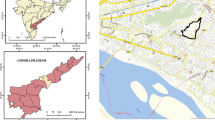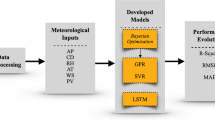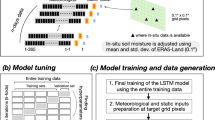Abstract
Accurate soil temperature prediction in cold climates is crucial for optimizing agricultural practices, hydrological processes, water resource management, minimizing frost damage, and mitigating flood risks. The capacity of deep learning methods to capture intricate patterns and relationships in climate data enhances the accuracy of soil temperature predictions and offers substantial benefits for reducing climate change impacts. In the present study, a comparative analysis of different deep learning techniques, including long short-term memory (LSTM), convolutional neural network (CNN), and multi-layer perceptron (MLP), for predicting the soil temperature is provided. The study examined cold climate areas across Canada, from snowy regions to Arctic conditions. Input datasets were considered both as time series and shuffled order. To comprehensively evaluate the predictive approaches for soil temperature, four machine learning (ML) models—CNN, LSTM, MLP in time series, and MLP on shuffled data—were employed. The results showed ML models using input data as time series have struggled with accurate soil temperature prediction, especially in very cold and polar climates, likely due to the presence of ice layers on the soil, limiting fluctuations near the freezing point. The normalized RMSE (NRMSE) for the CNN, LSTM, and MLP was calculated to be 8.6%. 7.4%, and 6.9%, respectively, and the scatter index (SI) for CNN, LSTM, and MLP was calculated to be 1.0%, 0.9%, and 0.9%, respectively. On the other hand, MLP-shuffled that employs shuffled input data outperformed others with an NRMSE of 5.4% and an SI of 0.7%, by creating a generalized data representation, free from presentation sequence bias. This study showed that predicting soil temperature in very cold climates poses a challenge for machine learning, yet the MLP-shuffled model excels, attaining superior accuracy through the creation of a generalized data representation independent of the sample sequence.










Similar content being viewed by others
Data availability
The datasets generated and analyzed during the current study are available from the corresponding author on reasonable request.
References
Babbar N, Kumar A, Kuma Verma V (2023) Forecasting wheat yield using long short-term memory considering soil and metrological parameters. 3rd Int Conf Int Commun Comput Tech ICCT 2023 Jaipur, India. IEEE pp 1-4. https://doi.org/10.1109/ICCT56969.2023.10076090
Bayatvarkeshi M, Bhagat SK, Mohammadi K, Kisi O, Farahani M, Hasani A, Deo R, Yaseen ZM (2021) Modeling soil temperature using air temperature features in diverse climatic conditions with complementary machine learning models. Comput Electron Agric 185:106158. https://doi.org/10.1016/j.compag.2021.106158
Beck HE, Zimmermann NE, McVicar TR, Vergopolan N, Berg A, Wood EF (2018) Present and future Köppen-Geiger climate classification maps at 1-km resolution. Sci Data 5:180214. https://doi.org/10.1038/sdata.2018.214
Belouz K, Zereg S (2023) Extreme learning machine for soil temperature prediction using only air temperature as input. Environ Monit Assess 195(8):962. https://doi.org/10.1007/s10661-023-11566-2
Bonakdari H, Moeeni H, Ebtehaj I, Zeynoddin M, Mahoammadian A, Gharabaghi B (2019) New insights into soil temperature time series modeling: Linear or nonlinear? Arch Meteorol Geophys Bioclimatol Ser B 135:1157–1177
Dai B, Yang W, Ji X, Zhu F, Fang R, Zhou L (2023) An ensemble deep learning model for short-term road surface temperature prediction. J Trans Eng Part B: Pavements 149:1. https://doi.org/10.1061/jpeodx.pveng-1192
Delbari M, Sharifazari S, Mohammadi E (2019) Modeling daily soil temperature over diverse climate conditions in Iran—a comparison of multiple linear regression and support vector regression techniques. Theoret Appl Climatol 135(3–4):991–1001. https://doi.org/10.1007/s00704-018-2370-3
Ebtehaj I, Bonakdari H, Samui P, Gharabaghi B (2023) Multi-depth daily soil temperature modeling: meteorological variables or time series? Theoret Appl Climatol 151(3–4):989–1012. https://doi.org/10.1007/s00704-022-04314-y
Farhangmehr V, Cobo JH, Mohammadian A, Payeur P, Shirkhani H, Imanian H (2023) A convolutional neural network model for soil temperature prediction under ordinary and hot weather conditions: comparison with a multilayer perceptron model. Sustainability 15:7897. https://doi.org/10.3390/su15107897
Hao H, Yu F, Li Q (2021) Soil Temperature Prediction Using Convolutional Neural Network Based on Ensemble Empirical Mode Decomposition. IEEE Access 9:4084–4096
Hou J, Wang Y, Zhou J, Tian Q (2022) Prediction of hourly air temperature based on CNN–LSTM. Geomat Nat Haz Risk 13(1):1962–1986. https://doi.org/10.1080/19475705.2022.2102942
Imanian H, Hiedra Cobo J, Payeur P, Shirkhani H, Mohammadian A (2022) A comprehensive study of artificial intelligence applications for soil temperature prediction in ordinary climate conditions and extremely hot events. Sustainability 14:8065. https://doi.org/10.3390/su14138065
Imanian H, Shirkhani H, Mohammadian A, Hiedra Cobo J, Payeur P (2023) Spatial interpolation of soil temperature and water content in the land-water interface using artificial intelligence. Water 15:473. https://doi.org/10.3390/w15030473
Ju J, Liu FA (2021) Multivariate time series data prediction based on ATT-LSTM network. Appl Sci (Switzerland) 11:20. https://doi.org/10.3390/app11209373
Mehdizadeh S, Behmanesh J, Khalili K (2018) Comprehensive modeling of monthly mean soil temperature using multivariate adaptive regression splines and support vector machine. Arch Meteorol Geophys Bioclimatol Ser B 133:911–924
Parveen N, Zaidi S, Danish M (2020a) Artificial intelligence (AI)-based friction factor models for large piping networks. Chem Eng Commun 207(2):213–230. https://doi.org/10.1080/00986445.2019.1578757
Parveen N, Zaidi S, Danish M (2020b) Comparative analysis for the prediction of boiling heat transfer coefficient of R134a in micro/mini channels using artificial intelligence (AI)-based techniques. Int J Model Simul 40(2):114–129. https://doi.org/10.1080/02286203.2018.1564809
Pomeroy JW, Brown T, Fang X, Shook KR, Pradhananga D, Armstrong R, Harder P, Marsh C, Costa D, Krogh SA, Aubry-Wake C, Annand H, Lawford P, He Z, Kompanizare M, Lopez Moreno JI (2022) The cold regions hydrological modelling platform for hydrological diagnosis and prediction based on process understanding. J Hydrol 615(A):128711. https://doi.org/10.1016/j.jhydrol.2022.128711
Samadianfard S, Ghorbani MA, Mohammadi B (2018) Forecasting soil temperature at multiple-depth with a hybrid artificial neural network model coupled-hybrid firefly optimizer algorithm. Inf Process Agric 5:465–476
Seifi A, Ehteram M, Nayebloei F, Soroush F, Gharabaghi B, Haghighi AT (2021) GLUE uncertainty analysis of hybrid models for predicting hourly soil temperature and application wavelet coherence analysis for correlation with meteorological variables. Soft Comput 25:10723–10748
Tabrizi SE, Xiao K, Van Griensven Thé J, Saad M, Farghaly H, Yang SX, Gharabaghi B (2021) Hourly road pavement surface temperature forecasting using deep learning models. J Hydrol 603:126877. https://doi.org/10.1016/j.jhydrol.2021.126877
Taheri M, Schreiner HK, Mohammadian A, Shirkhani H, Payeur P, Imanian H, Cobo JH (2023) A review of machine learning approaches to soil temperature estimation. Sustainability 15:7677. https://doi.org/10.3390/su15097677
Xing L, Li L, Gong J, Ren C, Liu J, Chen H (2018) Daily soil temperatures predictions for various climates in United States using data-driven model. Energy 160:430–440. https://doi.org/10.1016/j.energy.2018.07.004
Yener D, Ozgener O, Ozgener L (2017) Prediction of soil temperatures for shallow geothermal applications in Turkey. Renew Sustain Energy Rev 70:71–77. https://doi.org/10.1016/j.rser.2016.11.065
Yu L, Liu Y, Bu K, Wang WJ, Zhang S (2022) Soil temperature mitigation due to vegetation biophysical feedbacks. Global Planet Change 218:103971. https://doi.org/10.1016/j.gloplacha.2022.103971
Zeynoddin M, Bonakdari H, Gumiere SJ, Rousseau AN (2023) Multi-tempo forecasting of soil temperature data; application over Quebec. Can Sustain 15(12):9567. https://doi.org/10.3390/su15129567
Funding
This research was funded by the National Research Council Canada through the Artificial Intelligence for Logistics Supercluster Support Program, grant number AI4L-120.
Author information
Authors and Affiliations
Contributions
All authors contributed to the study conception and design. Material preparation, data collection, and analysis were performed by HI, AM, and VF. The first draft of the manuscript was written by HI. All authors commented on previous versions of the manuscript and all authors read and approved the final manuscript.
Corresponding author
Ethics declarations
Competing interests
The authors have no relevant financial or non-financial interests to disclose.
Additional information
Publisher's Note
Springer Nature remains neutral with regard to jurisdictional claims in published maps and institutional affiliations.
Rights and permissions
Springer Nature or its licensor (e.g. a society or other partner) holds exclusive rights to this article under a publishing agreement with the author(s) or other rightsholder(s); author self-archiving of the accepted manuscript version of this article is solely governed by the terms of such publishing agreement and applicable law.
About this article
Cite this article
Imanian, H., Mohammadian, A., Farhangmehr, V. et al. A comparative analysis of deep learning models for soil temperature prediction in cold climates. Theor Appl Climatol 155, 2571–2587 (2024). https://doi.org/10.1007/s00704-023-04781-x
Received:
Accepted:
Published:
Issue Date:
DOI: https://doi.org/10.1007/s00704-023-04781-x




